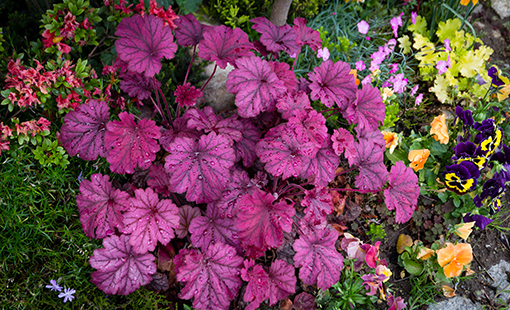
Caring for Coral Bells
Coral bells is a traditional perennial foliage plant with hundreds of varieties available, and new introductions offered every year. Native to North America, the plants form round mounds with a woody rootstock or crown at their base and small bell-shaped flowers that appear in spring or early summer on the tall stems. Rich in nectar, the flowers attract hummingbirds and butterflies, plus make nice cut blooms. Their leaves are rounded, lobed, hairy, and evergreen or semi-evergreen, depending on the climate. Besides traditional green-leaved coral bells, new varieties have leaves in shades of purple, rose, lime green, gold and more. Coral bells are best planted in late fall or early spring and will grow at a moderate pace, making them a great option for woodlands, rock gardens, containers, borders and ground covers.
Care
Coral bells make wonderful edging plants and put on a show when planted in groups. Their foliage is vibrant and saturated and is great for playing up the colors of nearby flowers in the garden—darker purple leaves can make yellow flowers glow, while butterscotch-colored leaves can bring out the tones of simple green leaves.
Caring for coral bells plants is pretty straight forward, and you likely won’t need to amend anything or prep in any serious way for their arrival in your garden. They like moderate moisture and will do well in partial shade, which is good news if you have a landscape filled with large shade trees.
Light
Coral bells do best in partial shade, especially in hotter climates. Their color can become washed out if they’re kept in full sun, and too much light can cause their leaves to scorch. Keep in mind, coral bells planted in damp shade can be prone to fungal diseases—if your plants start having problems, it’s best to move them to a drier site.
Soil
Coral bells prefer a humus-rich soil with a neutral to slightly acidic soil pH, somewhere between 6.0 and 7.0. Good drainage is a must, especially in shaded areas, as sitting in the damp soil will cause the crown of the plant to rot.
Water
This plant has medium water needs and likes consistently moist soil. Established plants will tolerate some drought, but an inch of water per week is the best way to keep them happy. If you grow your coral bells in full sun, plan to give them extra water—their shallow roots will need extra moisture during hot, sunny days.
Temperature and Humidity
Most coral bells are hardy in USDA hardiness zones 4-8, although exact hardiness does depend on the variety you’re growing. In cold areas, coral bells crowns can heave above the soil line in the winter. Winter mulching will help prevent the freezing/thawing cycle that pushes the plants up, and you should check periodically to make sure the roots are not exposed.
Fertilizer
Feed coral bells in the spring with a half-inch layer of compost or a light amount of slow-release fertilizer. This plant has light feeding needs; you should avoid heavy applications of quick-release fertilizers, as this will inhibit flowering. Container-grown coral bells benefit from feeding with a water-soluble fertilizer to replenish nutrients that leech from the soil.
Pruning
While coral bells don’t need much maintenance, you can cut back the entire flower stalk after flowering to put the plant’s energy into growing more leaves. Coral bells are short-lived perennials, so you’ll want to divide the plants every three to five years in the early spring or fall to keep them healthy. If the leaves get a bit ragged looking, especially after winter, cut them back and new growth should fill in quickly.
Common Pests & Diseases
The larvae of the black vine weevil can bore into the crowns and roots of coral bells in late summer or early fall, causing infected plants to wilt and droop. You should be able to see the larvae on the plant and remove them by hand and destroy them. If an infection persists, treat your plants with a mild insecticide or neem oil.
Information courtesy of TheSpruce.com

 Adams Fairacre Farms
Adams Fairacre Farms